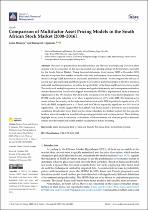| dc.description.abstract | The quest for parsimonious models has been a key objective in asset pricing. However, there
appears to be no consensus on the most successful asset pricing strategy in the literature, especially
for the South African Market. Using financial statements from January 2000 to December 2015,
this article explores how market anomalies affect the performance of securities in the Johannesburg
Stock Exchange’s (JSE’s) resources, industrial, and finance sectors. We investigated the efficacy of
several asset pricing models and their capacity to account for market anomalies in the JSE’s resources,
industrial, and financial sectors, as well as the applicability of the Fama and French five-factor model.
The study used multiple regression techniques and applied stationarity and cointegration methods to
ensure robust results. Results also suggest that when the FF5FM is implemented, there is statistical
significance at the 10% level for the CMA in the resources sector as the value factor disappears. The
FF5FM results in the industrial sector show a significance level of 5% in the SMB. The financial sector
seems to have the majority of the style-based risk factors as the SMB is positively significant at a 5%
level, the HML is significant at a 1% level, and the CMA is negatively significant at a 10% level of
significance. The results suggest that the Carhart Four Factor model is the best to use in all market
conditions. Results also show that value becomes redundant in a bullish market, but the opposite
holds in a bearish market for a model with operating profitably and investing factors. These findings
highlight the necessity for investors to determine which investment risk elements produce abnormal
returns in both bearish and bullish market circumstances before investing. | en_US |

